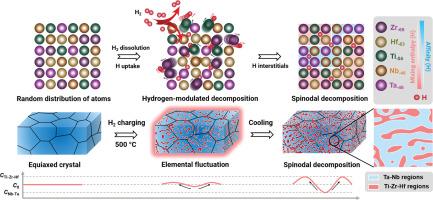Hydrogen-assisted spinodal decomposition in a TiNbZrHfTa complex concentrated alloy
IF 8.3
1区 材料科学
Q1 MATERIALS SCIENCE, MULTIDISCIPLINARY
引用次数: 0
Abstract
Understanding hydrogen-metal interactions is critical for developing refractory complex concentrated alloys (CCAs), applicable to the hydrogen economy. In this study, we revealed a hydrogen-assisted spinodal decomposition phenomenon at the nanoscale in an equiatomic TiNbZrHfTa CCA upon its exposure to H2 at 500 °C. Such a decomposition pathway was characterized by a periodic compositional modulation with an up-hill diffusion behavior of the principal metallic elements, particularly Zr, over an extended treatment period (from 0.5 h to 2 h) in an H2 atmosphere, probed by three-dimensional atom probe tomography. Consequently, the decomposed alloy consisted of a needle-shaped phase enriched in Zr and Ti and a phase enriched in Nb and Ta. Crystallographically, the spinodal features aligned preferentially along 〈001〉 directions of the matrix phase to minimize elastic strain energy. To better understand the role of hydrogen in spinodal decomposition, a statistical thermodynamic model was further developed by incorporating hydrogen to predict the phase stability of the TiNbZrHfTa-H system. This analysis suggested that hydrogen destabilizes the single solid-solution phase by expanding the spinodal region. Such nanoscale spinodal decomposition enhanced the hardness and anti-abrasive properties of the investigated alloy. Thus, this study not only provides fundamental insights into the effect of hydrogen on phase stability, but also demonstrates a novel alloy design strategy by introducing hydrogen as an interstitial alloying element to tailor the microstructure.


氢辅助下TiNbZrHfTa络合物浓缩合金的旋多分解
了解氢-金属相互作用对于开发适用于氢经济的难熔复杂浓缩合金(CCAs)至关重要。在这项研究中,我们揭示了氢在500°C下暴露于等原子的TiNbZrHfTa CCA中在纳米尺度上辅助的spinodal分解现象。通过三维原子探针层析成像探测,这种分解途径的特征是在H2气氛中延长处理时间(从0.5 h到2 h),主要金属元素的周期性成分调制和上坡扩散行为。因此,分解后的合金由富含Zr和Ti的针状相和富含Nb和Ta的相组成。晶体学上,spinodal特征优先沿<;001>;使弹性应变能最小的基体相方向。为了更好地理解氢在spinodal分解中的作用,我们进一步建立了一个统计热力学模型,通过加入氢来预测TiNbZrHfTa-H体系的相稳定性。这一分析表明,氢通过扩大旋峰区使单一固溶相不稳定。这种纳米尺度的旋轴分解提高了合金的硬度和抗磨蚀性能。因此,本研究不仅为氢对相稳定性的影响提供了基本见解,而且通过引入氢作为间隙合金元素来定制微观组织,展示了一种新的合金设计策略。
本文章由计算机程序翻译,如有差异,请以英文原文为准。
求助全文
约1分钟内获得全文
求助全文
来源期刊

Acta Materialia
工程技术-材料科学:综合
CiteScore
16.10
自引率
8.50%
发文量
801
审稿时长
53 days
期刊介绍:
Acta Materialia serves as a platform for publishing full-length, original papers and commissioned overviews that contribute to a profound understanding of the correlation between the processing, structure, and properties of inorganic materials. The journal seeks papers with high impact potential or those that significantly propel the field forward. The scope includes the atomic and molecular arrangements, chemical and electronic structures, and microstructure of materials, focusing on their mechanical or functional behavior across all length scales, including nanostructures.
 求助内容:
求助内容: 应助结果提醒方式:
应助结果提醒方式:


